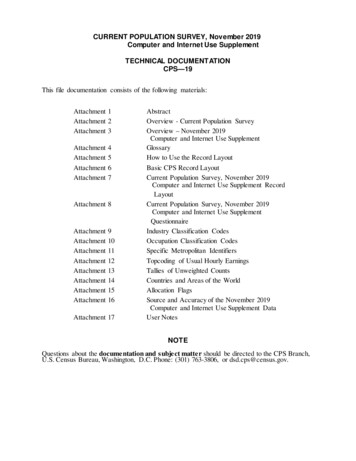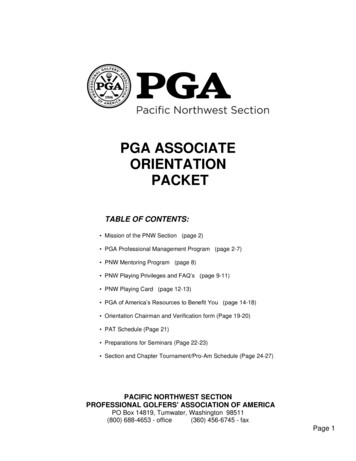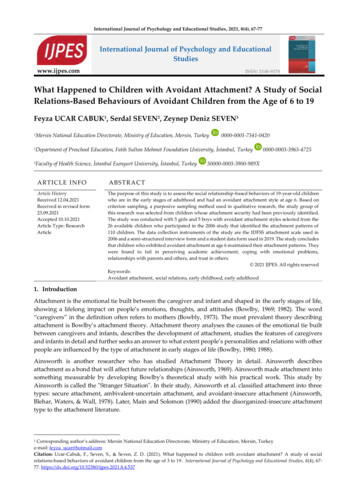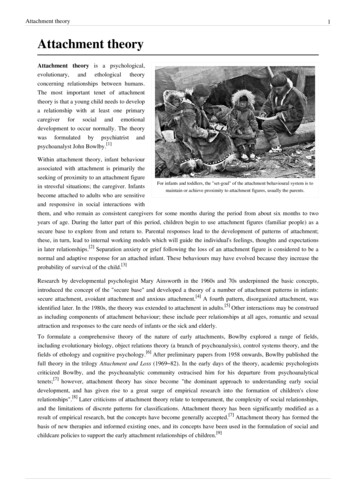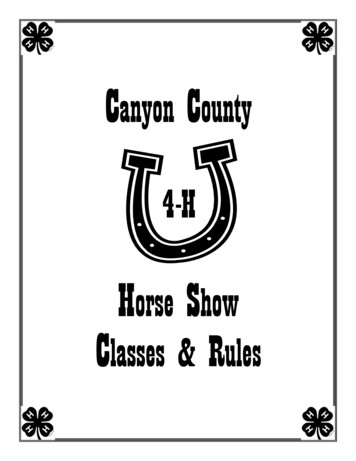
Transcription
Canyon County4-HHorse ShowClasses & Rules
1Adoption of Pacific Northwest 4-H Horse Contest Guide Rule Book (Effective February 1, 2018through September 30, 2018 version)With the following modifications Admissions:1. Page 2, Show Protocol, # 6 Any equipment or class rules may be modified or exceptionsmade by the fair superintendent at their discretion as needed for safety of special needsyouth.2. Page 2, Age divisions to include Novice I, Walk Trot Limited I, Walk Trot Limited II, Junior,Intermediate, Senior, FFA, Ranch I, & Ranch IINovice I (8-10 1st year showing)WT Ltd I (8-12 walk trot only for those kids and/or horses that are not ready to lope comfortably, safely, controlled, or just need more experienceshowing, etc.) A youth member is only eligible to win the High Point award in this division one time-- ever. This is based on the exhibitor-not thehorse/exhibitor pair. (Any exhibitor having won high point in the WT Ltd division prior to the creation of the new level is not eligible for the high point in thiscategory). Must show Showmanship in age division, i.e. Junior or Intermediate.WT Ltd II (13-18 walk trot only for those kids and/or horses that are not ready to lope comfortably, safely, controlled, or just need more experienceshowing, etc.) A youth member is only eligible to win the High Point award in this division one time-- ever. This is based on the exhibitor-not thehorse/exhibitor pair. (Any exhibitor having won high point in the WT Ltd division prior to the creation of the new level is not eligible for the high point in thiscategory). Must show showmanship in age division, i.e. Intermediate or Senior.Junior (8-10 walk trot lope)Intermediate (11-13 walk trot lope)Senior (14-18 walk trot lope)FFA (Showmanship ONLY—FFA youth will show all other classes in their respective age division)Ranch I (ages 8-12)Ranch II (ages 13-18)a. Any age group may be split by age or by # of contestants at the discretion of the fairsuperintendents;b. The fair superintendents may, depending upon the size of the class, combine classeswhen necessary and combined class will compete with one another and will not bejudged separately;3. Page 4, Project Animal—A shared horse can only be shown by one contestant in the sameChampionship Round age group. Two Senior or Two Junior showmen cannot show a sharedhorse in the Championship rounds. One Exhibitor must be selected to compete for theChampionship if a shared horse was used to qualify for the top showman.4. Page 5, “ project animals (owned, leased, shared) must be under the care andmanagement of the 4-H member at least “90” days before the animal may be shown at theofficial county exhibit activity. Declaration of project animal is required by April 15 of thecurrent year. (OR as required by CC Extension)5. Page 5, Clothing & Equipment – add at the end of the first paragraph, “No aggressive solesor are allowed. Crepe and aggressive soles are not recommended for riding activities.”Canyon County Horse Modifications to PNW 4-H Horse Contest Guide Rule BookEffective 01/01/2018 through 9/30/2018 – last printed 2021
2Strongly recommend that lace-up cowboy boots not be worn. Laces on English riding bootsare allowed.6. Page 6, Clothing & Equipment-Western Required: add at the end of bullet item ASTM/SEIequestrian-approved helmet (optional in showmanship). A helmet or cowboy hat must beworn in showmanship.7. Page 7, include Western Pleasure and Reining classes in paragraphs two and three.8. Page 11: The superintendent in cooperation with the judges will provide the ChampionshipRound pattern for Junior and Senior Showmanship classes. Those patterns shall be postedone half hour prior to the championship rounds for each division. The Championship Roundfor each division will not be conducted sooner than ½ hour after the completion of the lastage group participating in that division, i.e., Junior Showman and Senior Showman. It shallbe the show superintendent’s responsibility to obtain and post the pattern appropriately.9. Page 11: Shared Horse—a shared horse can only be shown by one contestant in the sameChampionship age group. Two Senior or Two Junior showmen cannot show a shared horsein the Championship rounds. One Exhibitor must be selected to compete for theChampionship if a shared horse was used to qualify for the top showman.10. Multiple Showmanship, English Equitation, and Western Equitation (Horsemanship) andReining patterns will be provided in the Canyon County Horse 4-H Pattern book and theshow patterns will be selected from the pattern book by the judge in cooperation with thesuperintendent and posted at least one hour prior to the class.11. Page 12, Class Procedure paragraph 2: add “or lead may be in a large loose coil in the lefthand” at the end of the second sentence and change the third sentence to: “The lead shallnot be held in small coils around the hand or fastened with a rubber band in a figure-8.”12. Page 16, modify Recommended jumping heights: 18” for Juniors, 24” for Intermediates, 30”for Seniors13. Page 18: Trail: Any items/décor/obstacles used in the patterns must be stable & secure—unable to fall, tip, flap significantly from external conditions (wind, unstable, not secure)other than by the horse/rider combination on the course having pulled, stepped on,knocked down, etc. This provides each exhibitor the reasonable expectation of beingjudged on the same course and conditions as their competition. Ranch Horse Trail shall beaddressed in a new section and is not subject to this clause.14. Page 18: modify second paragraph last sentence: Riders will be asked to move on afterthree refusals of attempts.Canyon County Horse Modifications to PNW 4-H Horse Contest Guide Rule BookEffective 01/01/2018 through 9/30/2018 – last printed 2021
315. Page 18: modify sixth paragraph after second sentence: Contestant may receive a zero for arefused obstacle but the contestant shall not be disqualified for refusals of an obstacleunless another violation such as abuse of the animal, falling from the animal, or otherviolations of the established rules are sufficient to cause disqualification.16. Page 16, HUNT SEAT EQUITATION OVER CAVALETTIS (set at 1’ or less) OR GROUND POLES(poles must be flat on the ground) English tack and attire required. Equitation criteria apply for evaluation/judging.PerformanceAny test listed under equitation may be asked. Performance will be judged on effectiveuse of aids on the entire course. Emphasis will be on light hands, balance, correctposture, and seat on the flat and over cavalettis or ground poles. Excessive speed will bepenalized.Before taking any jumps (cavalettis), including the warm-up jump, a safety inspectionshould be done. The inspection will include, but is not limited to, making sure the stirrupbars are open, the stitching on saddle stress points is in good repair, the girth is snug,and the bridle is properly fitted and in good repair.The course will consist of 5–12 jumps (cavalettis) or ground pole groupings, performed atthe appropriate gait for the division performing, with at least one change of direction. Thejudge may ask the class to do rail work at the walk/trot or walk/trot/canter both directionsof the ring in accord with the class/division being judged.The show patterns will be provided by the show superintendent and posted at least onehour prior to the class.17. HUNTER HACK OVER CAVALETTI OR FENCES & HUNTER HACK OVER GROUND POLESEnglish attire and tack required.Class Description:Hunter Hack is a transitional English class between hunter under saddle and workinghunter. Horses are required to jump two fences/cavalettis, or traverse ground poles thenput on the rail to walk, trot and canter both directions in the ring. Emphasis is on mannerand way of going on the flat and style over fences.Class Procedure:a. Horses are first required to jump/traverse two fences/poles set at or belowrecommended jumping heights and not to exceed three (3) feet at the discretion ofthe Horse Show Superintendent. However, if the jumps are set on a line they arerecommended to be in increments of 12 feet (3.5 meters) but adjusted to no lessthan two strides. A ground line is recommended for each jump.Canyon County Horse Modifications to PNW 4-H Horse Contest Guide Rule BookEffective 01/01/2018 through 9/30/2018 – last printed 2021
4b. Horses are then to be shown at all appropriate gaits for the division showing in the classboth ways of the ring with light contact.c. At the discretion of the judge, contestants may be asked to hand gallop (divisiondependent), pull up or back and stand quietly following the last fence.Judging Criteria:a. The hunter hack horse should move in the same style as a working hunter. The classwill be judged on style over fences/cavaletti/ground poles, even hunting pace, flat work,manners and way of going. The head should not be carried behind the vertical, giving theappearance of intimidation, or be excessively nosed out, giving a resistant appearance.b. When necessary to split large classes by running more than one go‐round, finalistsmust both be re‐jumped and reworked on the flat.c. Placing for the class shall be determined by allowing a minimum of 70 percent forindividual fence/cavaletti/ground pole work and a maximum of 30 percent for work onthe flat.d. Faults over fences/cavaletti/ground poles will be scored as in TWH Over Fences class.e. Elimination: Horses eliminated in over fence/cavaletti/ground poles portion of the classshall be disqualified: A total of three disobediences which can include any of the following: refusal,stop, run-out, or extra circle. Jumping an obstacle before it is reset. Bolting from the arena.f. Faults (to be scored accordingly, but not necessarily cause disqualification during therail work) include:(1) Being on wrong lead.(2) Excessive speed (any gait)(3) Excessive slowness (any gait)(4) Breaking gait(5) Failure to take gait when called(6) Head carried too low or too high(7) Nosing out or flexing behind the vertical(8) Opening mouth excessively(9) StumblingASTM/SEI equestrian-approved helmet, English equipment, snaffle, kimberwick or Pelham bitare required.The show patterns will be provided by the show superintendent and posted at least one hourprior to the class.Canyon County Horse Modifications to PNW 4-H Horse Contest Guide Rule BookEffective 01/01/2018 through 9/30/2018 – last printed 2021
518. WESTERN REININGWestern Attire and Tack RequiredClass DescriptionThis class will demonstrate the rider’s ability to achieve one of the three required reiningpatterns fluently, effortlessly and with reasonable speed throughout. Flying lead changesshould count over simple changes. Reining patterns will be posted. The judge will select one ofthese patterns at the show.Class Procedure Reining patterns in this rule book may be used at the discretion of the judge. Patterns will have varying degrees of difficulty, bearing in mind they are to be run by Noviceparticipants. Each entry to individually perform required pattern Horse to be judged on neatness, dispatch, ease, calmness and speed with which pattern isperformed. Horse shall rein easily, fluidly and with reasonable speed throughout pattern.Judging Requirements for all patterns Horse shall rein and handle easily Horse must have proper manners Any exhibitor not following exact pattern will be faulted The judge may require contestants to repeat all or portions of their runsFaults against Rider for all patterns Changing hands on reins Two hands on reins, refer to Appointments Losing stirrup or holding on Any unnecessary aid given by the rider (such as unnecessary talking, petting, spurring,quirting, jerking of reins, etc.) Not following exact patternPatterns will be posted one hour before the class—some patterns are provided in thefollowing pages. Other reining or reining type patterns will be included in the Canyon CountyHorse Leaders’ Pattern books for both Walk Trot classes and Reining classesCanyon County Horse Modifications to PNW 4-H Horse Contest Guide Rule BookEffective 01/01/2018 through 9/30/2018 – last printed 2021
6REINING PATTERNS – NoviceReining Pattern #1StopJudgeStart1.2.3.4.5.6.7.8.Run down fence past center marker and stop.Back to center marker.Do a 90 turn to left-jog to center of circles.Pick up lope on right lead.Lope large circle to right, change leads at center.Lope left lead large circle to left, continue to judge and stop.Inspection by judge.Wait for dismissal.Reining Pattern #2Judge1.2.3.4.5.6.7.Start run at first marker, and run down to end marker, right rollback.Run back down to first marker, left rollback.Continue to center on left lead, at center point change to right.Do a slower smaller figure 8 changing leads in center.Do a faster figure 8 changing leads in the center.Continue out of circle towards judge, sliding stop.BackCanyon County Horse Modifications to PNW 4-H Horse Contest Guide Rule BookEffective 01/01/2018 through 9/30/2018 – last printed 2021
7REINING PATTERN – Intermediate & SeniorCanyon County Horse Modifications to PNW 4-H Horse Contest Guide Rule BookEffective 01/01/2018 through 9/30/2018 – last printed 2021
8REINING PATTERNS – Intermediate and SeniorNRHA Pattern #2Patterns will be posted one hour before the classCanyon County Horse Modifications to PNW 4-H Horse Contest Guide Rule BookEffective 01/01/2018 through 9/30/2018 – last printed 2021
9NRHA Pattern #11Patterns will be posted one hour before the classCanyon County Horse Modifications to PNW 4-H Horse Contest Guide Rule BookEffective 01/01/2018 through 9/30/2018 – last printed 2021
1019.WALK TROT Classes from CCRBClass DescriptionWalk Trot Limited I & II classes shall be conducted with the same rules and criteria asdescribed in the rule book with the exception that the exhibitors shall not be asked toperform at the lope. Classes shall be ridden in the required discipline (English orWestern) for the class being exhibited in.Judging Criteria and Scoring See Performance Guidelines section of the manual Exhibitors are to be judged at the standstill, back, and walk, jog or trot bothdirections of the ring.Class Routine Exhibitors will enter the ring at the walk Horses are being judged at the walk, jog or trot both directions of the ring. Horses will be required to back. Horses are to back readily and stand quietly. Horses may be required to reverse at the walk, jog or trot.20.IN-HAND TRAIL from CCRB (In-hand trail for horse projects are two years old or underand Miniature Horses)Judge will create courseClass DescriptionThis is a class to demonstrate the exhibitor’s ability to maneuver their horse over andthrough various obstacles while being led. The horse’s manner, maneuverability,attitude and response to the rider at the walk and jog will be taken into consideration.This class may be entered in western or English attire.Judging Criteria: See “Trail” criteriaScoring: See “Trail”Class Routine: See “Trail”Obstacles & Penalties: See “Trail” sectionCanyon County Horse Modifications to PNW 4-H Horse Contest Guide Rule BookEffective 01/01/2018 through 9/30/2018 – last printed 2021
1121.GREENHORSE classes from CCRBGREENHORSE WEANLINGClass DescriptionThis class is open to weanlings foaled in the current year. This class gives the handler anopportunity to demonstrate the training and techniques used in establishing goodground manners and basic handling. This class may be entered either English orWestern.Judging CriteriaThis class is to be judged on the exhibitor’s ability to control their horse and maneuveraround their horse while doing the required exercises. The judge will consider how wellthe maneuvers attempted are accomplished and whether adequate progress has beenmade during the time in training.Scoring Showing/Handling of the horse 60% Appearance/Behavior of Horse 30% Appearance of Exhibitor 10%Class RoutineThere will be one horse at a time in arena. Exhibitors may have a properly dressed 4-Hyouth attendant in the arena to assist them in holding the horse and/or equipment.Absolutely no mares allowed in the arena.A time limit of 10 minutes is recommended.Exhibitors will be asked to demonstrate the following: Lead at walk Pick up both front feet. Groom (body, mane & tail) Present horse for inspectionTack Halter & Lead rope (Minimum 8 feet long) Grooming Box Chains are NOT allowed Attire may be Western or EnglishCanyon County Horse Modifications to PNW 4-H Horse Contest Guide Rule BookEffective 01/01/2018 through 9/30/2018 – last printed 2021
12GREENHORSE YEARLINGClass DescriptionThis class is open to yearlings that are 1 year old as of January 1st of the current year.This class gives handlers the opportunity to demonstrate the training and managementused in establishing good grand manners and basic handling techniques. This class maybe entered either English or Western.Judging CriteriaThis class is to be judged on the exhibitor’s ability to control their horse and maneuveraround their horse while doing the required exercises. The judge will consider how wellthe maneuvers attempted are accomplished and whether adequate progress has beenmade during the time in training.Scoring Showing/Handling of the horse 60% Appearance/Behavior of Horse 30% Appearance of Exhibitor 10%Class RoutineThere will be one horse at a time in arena. Exhibitors may have a properly dressed 4-Hyouth attendant in the arena to assist them in holding the horse and/or equipment.A time limit of 15 minutes is recommended.Exhibitors will be asked to demonstrate the following Showmanship pattern (As directed by judge) Pick up both front feet Lunge horse (walk, and trot both directions)Tack Halter and Lead Rope (Minimum 8 feet long) Lunge Line Chains are not recommended, if used MUST be under the chin and lay flat Attire may be Western or EnglishGREENHORSE – FIRST YEAR UNDER SADDLEClass DescriptionThis class is open to any horse in their first year under saddle. This class gives thehandler an opportunity to demonstrate the training used in teaching the horse to carrya rider at the walk, trot, and lope. Exhibitors will also be able to demonstrate theirCanyon County Horse Modifications to PNW 4-H Horse Contest Guide Rule BookEffective 01/01/2018 through 9/30/2018 – last printed 2021
13ability to work the horse both on and off the rail. This class may be shown English orWestern.Judging CriteriaThis class is to be judged on the exhibitor’s ability to control their horse and completethe required exercises gaits and movements asked. The judge will consider how well themaneuvers attempted are accomplished and whether adequate progress has beenmade during the time in training.Scoring Horses understanding & willingness to do what is asked of them 45% Riders equitation and use of aides 40% Appointments 15%Class Routine There will be one horse in the arena at a time. Exhibitors may ride English or Western with appropriate attire A time limit of 15 minutes is recommendedExhibitors will be asked to demonstrate the following: Ride on the rail at a walk, trot, and lope both directions. Lope/Canter horse down center of arena demonstrating right and left leads and abalanced stop Horse to remain at a standstill for 30 seconds Back horse a minimum of 6 steps, with little or no hesitation Rider may be asked to mount & dismount Rider may be asked to complete additional pattern work as requested by the judgeTack English or Western Saddle and Bridle Snaffle Bit, Curb bit, Bosal, or Sidepull will be allowed. Curbs, Snaffles and Sidepull must have curb strap If a Bosal is used, Mecate rope is to be slid through the riders belt loop in a mannerthat is easily removed Spurs are not allowed Attire may be Western or EnglishGREENHORSE – SECOND YR. UNDER SADDLEClass DescriptionThis class is open to any horse that has been ridden under saddle less than three years.This class gives the handler an opportunity to demonstrate the training used in teachingCanyon County Horse Modifications to PNW 4-H Horse Contest Guide Rule BookEffective 01/01/2018 through 9/30/2018 – last printed 2021
14the horse to carry a rider at the walk, trot, and lope. Exhibitors will also be able todemonstrate their ability to work the horse both on and off the rail. This class may beridden English or Western.Judging CriteriaThis class is to be judged on the exhibitor’s ability to control their horse and completethe required exercises gaits and movements asked. The judge will consider how well themaneuvers attempted are accomplished and whether adequate progress has beenmade during the time in training.Scoring Horses understanding & willingness to do what is asked of them 45% Riders equitation and use of aides 40% Appointments 15%Class Routine There will be one horse in the arena at a time. Exhibitors may ride English or Western with appropriate attire A time limit of 15 minutes is recommendedExhibitors will be asked to demonstrate the following Ride on the rail at a walk, trot, and lope both directions. Complete two figure 8 patterns at a canter/lope demonstrating both a simple andinterrupted change of lead Horse to remain at a standstill for 30 seconds Back horse a minimum of 6 steps, with little or no hesitation Demonstrate side passing both left and right with a minimum of 6 steps, both frontand hind legs are to cross over Rider may be asked to mount & dismount Rider may be asked to complete additional pattern work as requested by the judged.Tack English or Western saddle and bridle Snaffle Bit, Curb bit, Bosal, or Sidepull are allowed Curbs, Snaffles and Sidepull must have curb strap If a bosal is used, mecate rope is to be slid through riders belt loop in a manner thatit is easily removed Spurs are allowed. If western they are to be dull with free moving rowels. If Englishthey are to be a standard blunt slip on’ Attire may be Western or EnglishCanyon County Horse Modifications to PNW 4-H Horse Contest Guide Rule BookEffective 01/01/2018 through 9/30/2018 – last printed 2021
1522. Young Green Horse: (addendum January 2018)(Only available when provided for by County Fair or 4H Horse Show Chairman/Superintendent asan option at a particular event)Young Green Horse—Second Project Horse eligibility for 4-H Horse showThe purpose of providing 4-H youth (14-18 years old-Seniors Only) the opportunity to show asecond project animal --young/green horse (minimum two (2) years of age to a maximum four (4)years or age) in the Walk Trot Limited II classes is to allow youth a safe and controlled showenvironment to expose young project animals to the horse show environment and to compete inan entry-level field with youth and/or horses of the same level of experience. This limited optionis intended to be a stepping-stone to the more advanced level of competition with seasonedhorses. Horse and rider must comply with clothing & equipment requirements as described in thePacific Northwest 4-H Horse Contest Guide.Young Green Horses that are deemed to be unsafe or disruptive for the exhibitor or other youthexhibitors in the Walk Trot Limited II division shall be dismissed from the class and/or show at thejudge’s or superintendent’s discretion. [For a young horse and/or young inexperienced exhibitor–“unsafe” is subjective but clear—and may include unruly, scared (horse or rider), out of control,kicking, biting, exhibiting signs of high stress, or tendencies to protect themselves (bolting, shying,significant laying back ears, threateningly swinging hips/head—i.e. body language) from or atapproaching animals which may lead to unsafe behavior such as kicking, bucking, etc.]This option to show a “young green horse” in the Walk Trot Limited II division is not intended tolimit youth from using different project animals in their primary exhibitor division—i.e. Seniordivision.Eligible for Walk Trot Limited II division only (as second show animal)Requirements:Age of Horse: minimum 2 years old maximum 4 years oldExhibitor Age: 14 – 18 years old (Seniors only)Equipment for the day of show: Exhibitor must have adequate and appropriate equipment forboth project animals and each animal shall be saddled and ready to enter show ring—this includesbut is not limited to saddles, bridles, blankets to minimize the disruption to fellow competitorsand show staff.High Point Awards: Rider is eligible for Walk Trot Limited II high point award and may only winthe award one time. It is not based on horse/rider pair. If the exhibitor at any time in their 4-HHorse Project career has one a Walk Trot Limited high point award they are not eligible for thehigh point.Showmanship: Only ONE project animal can be shown in Showmanship. The WT Ltd I & IIcompetitors must show in the appropriate age category (Junior, Intermediate, Senior). The youthcompetitor must declare which horse will be shown for showmanship at the Fair and pointsobtained in showmanship shall only be recorded to the specified horse for calculation of highpoint awards.Canyon County Horse Modifications to PNW 4-H Horse Contest Guide Rule BookEffective 01/01/2018 through 9/30/2018 – last printed 2021
16Class Preparedness:The exhibitor may have very limited time between primary and secondary horse classes.There may not be any time to warm-up the horse before entry into the arena is expectedand required. Classes/Gate Holds will not be available for the purpose of significantequipment changes and/or warming up of project animals. It is strongly encouraged thatthe parent or leader of an exhibitor showing two project animals have the animal ready togo and in the vicinity of the arena to be shown in.Gate Holds will be available if the exhibitor is in a scheduled class that is in progress inanother arena with the primary or secondary animal and the exhibitor will be given a fewminutes to change animals including the unbridling and tying-up of one animal and thebridling and mounting of the second animal. It is strongly encouraged that the parent orleader of an exhibitor showing two project animals have the animal ready to go and in thevicinity of the arena to be shown in.Young Green Horse Guidelines in addition to existing PNW horse project requirements:(Adapted from Penn State Extension document)1. All 4-H members must abide by county policies and current 4-H Horse Show rules forparticipation in the 4-H Horse Project Show. To be eligible to compete, all 4-Hmembers must have completed appropriate project requirements as determined bytheir respective county.2. The young green horse allowance is recommended for youth at least 14 years andpreferably older, or more experienced 4-H members. All 4-H members should becarefully supervised when working with young green horse project animals.Supervision and guidance of younger members is especially important. Safety mustbe considered at all times and is especially important when youth are working withyoung horses.3. The 4-H member should care for (feed, exercise and handle) the project animal(s) themajority of the time with appropriate adult supervision. In the event the animal isleased and/or stabled away from the 4-H member’s home, the 4-H member shouldbe actively involved in working with the animal on a regular basis.4. Appropriate adult involvement is encouraged, yet adults should not perform themajority of the work with the project animal(s). Adults are encouraged to work withyouth, and assist them to safely and properly handle and care for their projectanimal(s).5. Parents, leaders, and experienced adults should work with youth and their younggreen horse project animals to teach correct handling, training, conditioning, andshowing methods. Youth should understand and practice correct procedures whenpreparing horses for shows. Consult reputable professionals or experienced adults asneeded to assist youth.Canyon County Horse Modifications to PNW 4-H Horse Contest Guide Rule BookEffective 01/01/2018 through 9/30/2018 – last printed 2021
171. 23. GAMING classes from CCRBTIMED EVENTS & GAMES Figure 8 Race Key Hole Race Flag Race Ribbon Race Dollar Bill Race Simon Sez Pole BendingBarrelsEgg & Spoon RaceAustralian PursuitPairs ClassTIMED EVENTS GENERAL RULES1. In the event of a tie, the exhibitor declared the winner, in the run-off, must run inthe pattern within two seconds of its original time, or the run-off must be heldagain.2. Failure to follow the course will cause a disqualification and a “no time” will begiven.3. A five-second penalty will be added for each barrel or pole knocked down.4. Barrel and pole courses may be run to the left or right.5. A clearly visible start and finish line will be provided by: a) Flags tied to the fence ateye level. b) A line marked by lime. c) An electric timer and flags.6. All courses must be set to provide ample room to turn and stop.7. In Barrel Racing and Pole Bending courses must be measured exactly.8. Measurement: In barrel racing, measurements may be reduced five yards at a time inconsideration of arena size. (Final barrel need not be reduced.)9. The following timers will be used: One electric timer and two hand-held digital stop watches as backup, or Three hand-held digital stopwatches. In the event that the electric timer fails, or the hand-held timers must be used,the average time of the hand-held timers will be used as the official time. A flag person will be provided at the start and end of each run as a backup.10. Times will be recorded to include hundredths of a second if possible.11. Two hands may be used on the reins.12. No exhibitor will begin the run without first hearing the signal, “Timers or flaggersare ready,” from the announcer.13. In Gymkhana events or roping events, properly fitted ASTM/SEI equestrian-approvedhelmet required at all times while on horse. Western hats must remain on the headpast the start of the run unless management states hats are not required (SeeGLOSSARY – “Start of Run”)
Canyon County Horse Modifications to PNW 4-H Horse Contest Guide Rule Book Effective 01/01/2018 through 9/30/2018 - last printed 2021 Adoption of Pacific Northwest 4-H Horse Contest Guide Rule Book (Effective February 1, 2018 . will be judged on style over fences/cavaletti/ground poles, even hunting pace, flat work, manners and way of going .
